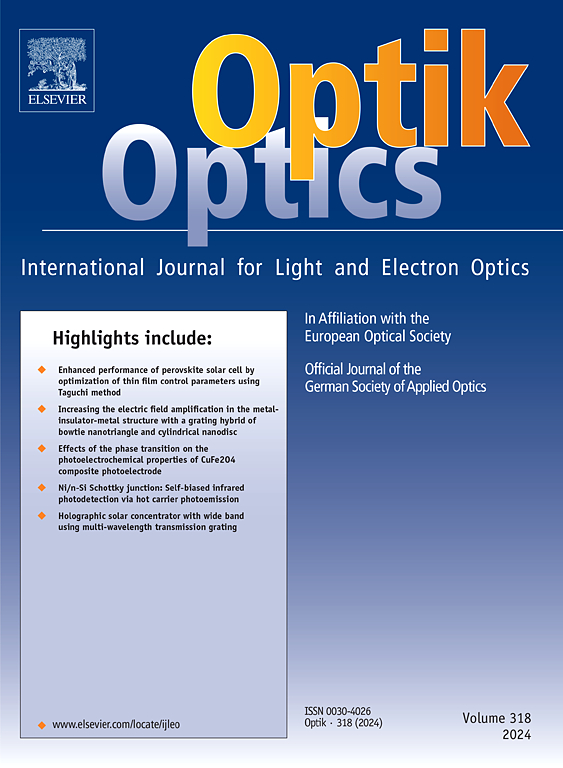基于DFT第一性原理GGA+U+SOC方法的掺铕氯化铯锡钙钛矿带隙工程和光电子特性研究
IF 3.1
3区 物理与天体物理
Q2 Engineering
引用次数: 0
摘要
本研究探讨了铕掺杂铯锡氯化钙钛矿(eu -掺杂CsSnCl₃)作为LED应用的荧光粉材料的潜力。我们使用第一性原理计算进行了计算分析,特别是通过WIEN2k软件实现GGA+U+SOC方法,以评估铕(Eu)取代掺杂如何影响材料的电子和光学行为。该研究比较了纯CsSnCl₃和两种铕掺杂浓度:单原子Eu-CsSnCl₃(2.5 %)和双原子2Eu-CsSnCl₃(5 %)。研究结果表明,铕的掺入显著改变了电子能带结构,带隙从原始CsSnCl₃的3.2 eV减小到2.5%和5%铕浓度下的1.009 eV和0.967 eV。这种修饰是通过在价带和导带内形成附加电子态而发生的。研究表明,与原始材料和5%铕变体相比,2.5%铕浓度产生了最佳的光学特性,特别是在可见光波长内,表现出更好的吸收系数和更明显的光学特性。通过对介电特性、光学导电性和能量损失模式的研究,我们确定铕的掺入为光吸收和发射过程创造了最佳条件。这些结果表明,精确控制Eu掺杂CsSnCl 3代表了一种可行的方法,可以开发具有可调颜色特性和增强性能的先进荧光粉材料,用于未来的LED应用。本文章由计算机程序翻译,如有差异,请以英文原文为准。
Band gap engineering and optoelectronic properties of europium-doped cesium tin chloride (Eu-doped CsSnCl3) perovskite using a DFT based first-principles GGA+U+SOC approach for PC-LED applications
This research investigates the potential of europium-doped cesium tin chloride perovskite (Eu-doped CsSnCl₃) as phosphor material for LED applications. We conducted computational analysis using first-principles calculations, specifically implementing the GGA+U+SOC methodology through WIEN2k software, to evaluate how europium (Eu) substitutional doping affects the material's electronic and optical behavior. The study compared pure CsSnCl₃ with two europium doping concentrations: a single-atom case Eu-CsSnCl₃ (2.5 %) and a double-atom scenario of 2Eu-CsSnCl₃ (5 %). Our findings demonstrate that Eu incorporation significantly alters the electronic band structure, with the band gap decreasing from 3.2 eV in pristine CsSnCl₃ to 1.009 eV and 0.967 eV for the 2.5 % and 5 % europium concentrations, respectively. This modification occurs through the formation of additional electronic states within both the valence and conduction bands. The research revealed that the 2.5 % europium concentration yielded optimal optical characteristics, particularly within visible light wavelengths, exhibiting improved absorption coefficients and more pronounced optical features compared to both the pristine material and the 5 % Eu variant. Through examination of dielectric properties, optical conductivity, and energy loss patterns, we determined that europium incorporation creates optimal conditions for light absorption and emission processes. These results indicate that precisely controlled Eu doping of CsSnCl₃ represents a viable approach for developing advanced phosphor materials with adjustable color properties and enhanced performance for future LED applications.
求助全文
通过发布文献求助,成功后即可免费获取论文全文。
去求助
来源期刊

Optik
物理-光学
CiteScore
6.90
自引率
12.90%
发文量
1471
审稿时长
46 days
期刊介绍:
Optik publishes articles on all subjects related to light and electron optics and offers a survey on the state of research and technical development within the following fields:
Optics:
-Optics design, geometrical and beam optics, wave optics-
Optical and micro-optical components, diffractive optics, devices and systems-
Photoelectric and optoelectronic devices-
Optical properties of materials, nonlinear optics, wave propagation and transmission in homogeneous and inhomogeneous materials-
Information optics, image formation and processing, holographic techniques, microscopes and spectrometer techniques, and image analysis-
Optical testing and measuring techniques-
Optical communication and computing-
Physiological optics-
As well as other related topics.
 求助内容:
求助内容: 应助结果提醒方式:
应助结果提醒方式:


